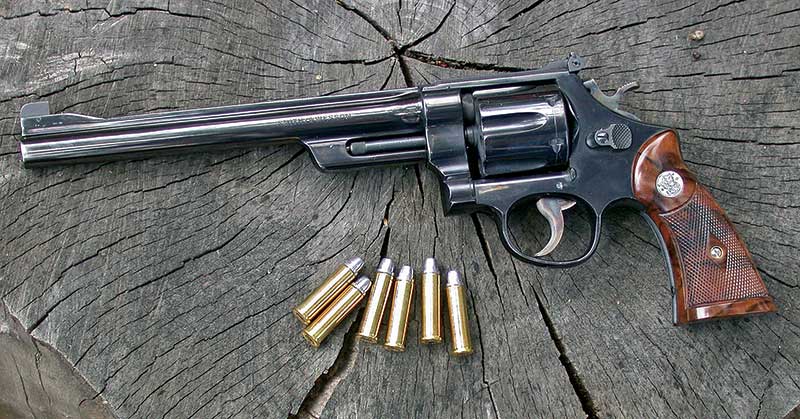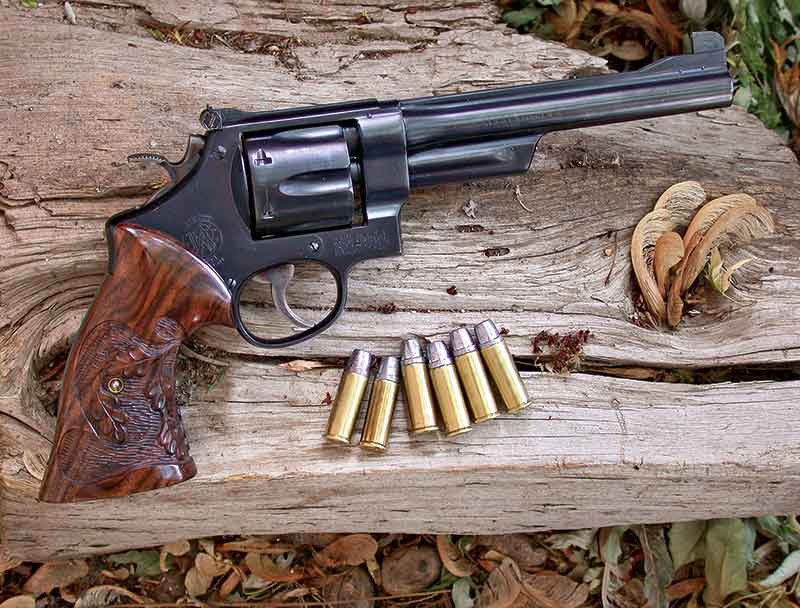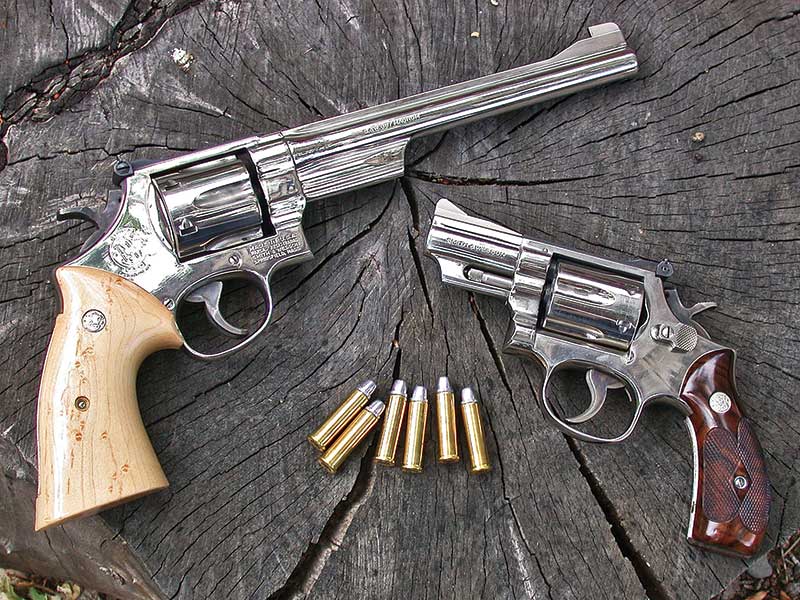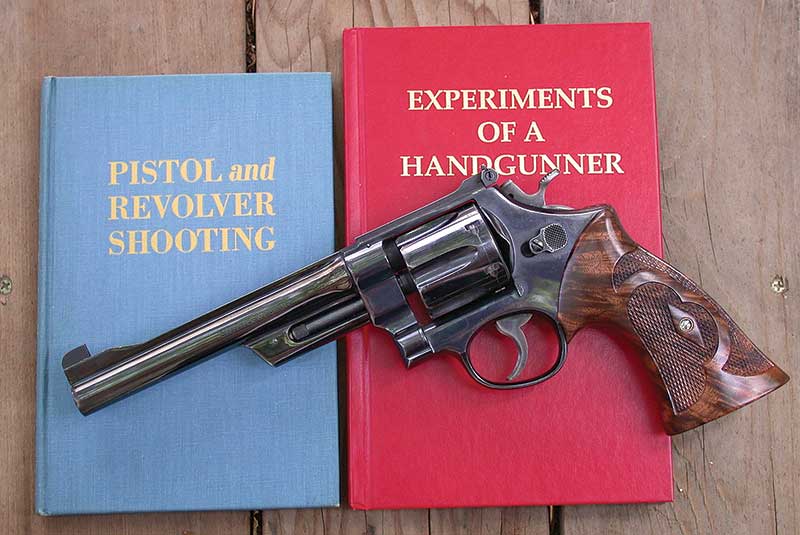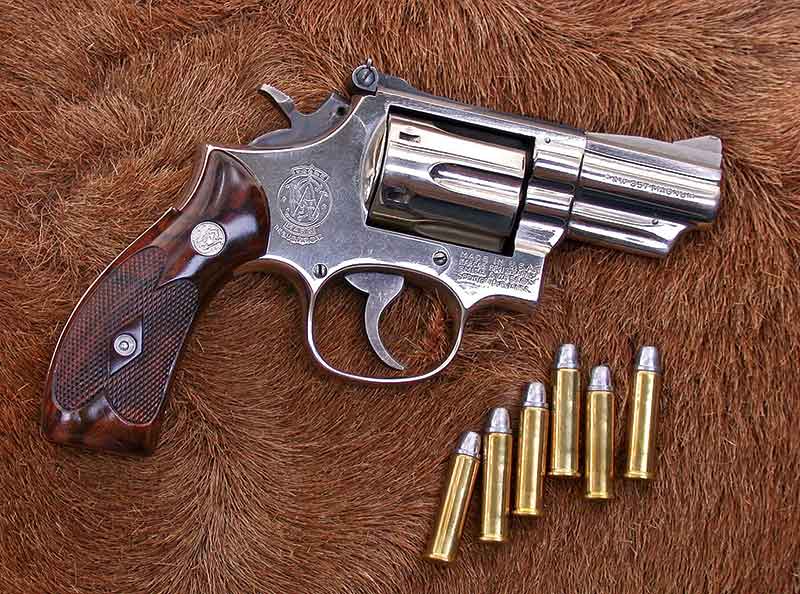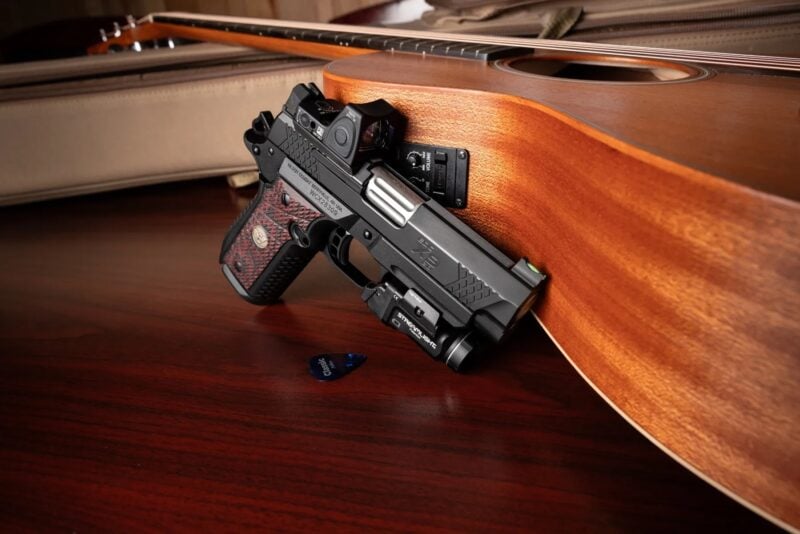A True Sixgunner's Dream
Classic Carved Grips Found!
There was a time in my life — in the first half of the 1960’s — I mostly lived on dreams. When I wasn’t working, sleeping or attending classes, I often dreamed of the sixguns I would have in the future. Those dreams were inspired by such books as Elmer Keith’s Sixguns, Ed McGivern’s Fast and Fancy Revolver Shooting and Walter Roper’s Pistol and Revolver Shooting. On page 179 of Keith’s Sixguns there’s a picture of four of his Smith & Wesson double-action sixguns: A 61/2″ .357 Magnum, a 61/2″ .44 Special Triple-Lock Target, a 4″ .44 Special 1950 Target and a 6″ K-22 Masterpiece. The last line in the caption says, “Kearsarge custom grips on top two guns.”
There’s a much better picture of Kearsarge grips on page 455 of McGivern’s book and he also mentions Kearsarge and Walter Roper on page 287. In Roper’s book, of course, we have more pictures of stocks by the author, who also designed the “Target” grip for the Smith & Wesson .357 Magnum which carried over to.44 Specials and the .44 Magnum.
By the time I could even think of buying more sixguns — let alone custom grips — both Roper and Kearsarge were gone. Anyone who found an old Smith & Wesson sixgun equipped with either grip really found something special. What’s interesting about both grips is the fact Roper grips weren’t made by Roper, and Kearsarge was not a man, but a mountain. Walter Roper was a designer, not a woodworker, and Kearsarge Woodcraft Co. put out grips made by one Charles Wendell Jr. In either case, the work was magnificent.
History Lesson
Thanks to an article, “The Gripping Story of Walter F. Roper” by Kevin Williams, we know a lot more about the famed grip maker. Williams tells us while he was shooting a .45 ACP Smith & Wesson Model 1917 in 1921, Roper realized something needed to be done about the grips, and his experiments began. After meeting a French clockmaker by the name of Mathias Gagne, Roper’s designs were translated into wood. The fleur-de-lis pattern of the checkering is thanks to the Frenchman’s heritage. Roper didn’t care much for it; however, we can be thankful he allowed it to stay.
When it comes to Kearsarge custom grips we know Wendell pre-dated Roper, as he started making grips in the 1920’s. He esablished Kearsarge Woodcrafters in the 1930’s in sight of the mountain for which it was named.
Both Walter Roper and Charles Wendell started making grips designed for target shooters. The coming of the Magnum double-action sixguns made the filler behind the trigger guard just as important for the peace officer, outdoorsman, hunter and anyone who shot any heavily-loaded double action sixgun. There was a time when Smith & Wesson grips closely followed the Roper design, however this disappeared with the demise of the “diamond” stocks.
Several companies offer Roper’s design for double-action revolvers. However, carved and checkered examples could not be found until now. Wendell specialized in an oak leaf design in his carvings and these also have been lost to time — again, at least until now.
I recently discovered Classic Carved Grips — a one-man operation by Keith Brown. I say I discovered him, but actually someone mentioned him on an online forum and I was immediately enraptured by the pictures on his website. I arranged for him to send a pair of carved Ropers along with some other samples.
Once I put all those samples on Smith & Wesson sixguns, there was no turning back! Try as I might, I couldn’t get my screwdriver to go into reverse, so Diamond Dot wrote a check for all of them. If anyone can resist Keith Brown’s stocks or grips — whichever terminology you prefer — I would wonder about whether or not you had a real sixgunner’s heart.
Dreams Come True
The original order was for a set of carved and checkered Roper-style grips of exhibition claro walnut. These were ordered to go on a Smith & Wesson 1950 Target .44 Special. However, a second pair of grips, as we’ll soon see, changed my mind.
Instead of going on the .44, the Ropers were installed on a most appropriate substitute: a 61/2″ pre-Model 27 Smith & Wesson .357 Magnum. I’ve seen several pictures of the original .357 Magnum with Roper stocks so it just seemed natural for me to follow the pattern. The Ropers are beautifully carried out, with exquisite grain pattern, perfect carving and checkering. Most importantly, they fit my hand perfectly. Keith requires a hand pattern for every set of grips — obviously paying great attention to it.
The grips, which caused the change in sixguns, were a set of Kearsarge grips of French walnut with the Charles Wendell-style oak leaf carving — just as on Elmer Keith’s .44 Special Triple-Lock Target. These are also perfect, with their shape, carving and checkering fitting my hand neatly. It’s taken over 40 years to have a set of Kearsarge stocks on a .44, and my .44 Special isn’t a Triple-Lock Target, but a 61/2″ Model 1950 — more than close enough for me.
It took a long time to locate a 61/2″ S&W .357 Magnum. I’d have settled for any pinned and recessed Model 27 and I feel very fortunate I found a pre-27 on an online site and at an especially attractive price. This sixgun definitely deserved the Ropers as much as the 1950 Target, now complete with the Kearsarge stocks. Two classic Smith & Wesson sixguns from the early 1950’s now have equally classic grips from the first half of the 20th century.
The third pair from Keith Brown perfectly matched the smooth-finished Roper-style Smith & Wesson target stocks of the pre-war period. Made of Birdseye maple, these stocks are a perfect complement to an 83/8″ Model 27 and especially a nickel-plated one. Once I put them on the .357 Magnum sixgun, I spent a beautiful Idaho morning putting several hundred rounds of full-house cast bullet loads through the long-barreled Smith & Wesson.
The .357 Magnum is no .44 Magnum, but repeated firing will definitely find any hotspots on grips. The Keith Brown stocks came through with perfect performance. This sixgun never looked better or provided more pleasurable shooting.
Keeping History Alive
The last two pair consists of pre-war style Magna grips. For N-frames with a square butt — as all N-frames should be — I received exhibition French walnut with scrimshawed elephant ivory S&W medallions. These went on another 83/8″ pre-Model 27, finished in the old Bright Blue. Most of the post-1950 S&W Magna stocks are slightly blocky, however this pair from Keith Brown are perfectly rounded and set this blued Smith off to perfection. I knew as soon as they went on this sixgun there was no way the screwdriver would ever be able to remove them. I’m certainly thankful Diamond Dot understands!
The second set of Magnas is for a round butt K-frame and crafted of exhibition French walnut. These were actually Brown’s personal stocks and he re-finished them before sending them to me. He’ll just have to make another set! These are now on one of the all-time great concealment sixguns, a 21/2″ Model 19 .357 Magnum.
We live in a world where most things are turned out by machinery. It’s always refreshing to find a real craftsman working with his hands to keep history alive.
For more info: Visit the maker’s website at www.kbgrips.com, e-mail: [email protected]

